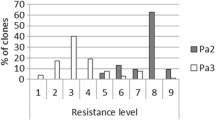Summary
Within the two potato cyst nematode (PCN) species, Globodera rostochiensis and G. pallida, eight pathotypes are presently discerned by seven differential Solanum clones, whereby resistance is defined as a Pf/Pi ratio <1.0, and susceptibility as a ratio above 1.0. This pathotyping is felt to be unsatisfactory. Reconsidering the original data and data published by others resulted in the conclusion that there are only three reliably recognizable Ro-pathotypes Ro1/Ro4, Ro2/Ro3 and Ro5. The differential clones 60.21.19 and 65.346.19 differentiate only between the two species. Within G. pallida it does not seem possible to identify pathotypes reliably. The resistance-virulence pattern is of a quantitative nature fitting a polygenic system. There appear to be pathotype-specific effects, which are not large enough to identify and classify pathotypes reliably. It is therefore suggested to rename the Ro-pathotypes into Ro1 (old Ro1 and Ro4), Ro3 (old Ro2 and Ro3) and Ro5 (old Ro5) and to speak of more and less virulent Pa-populations.
The rigorous requirements for resistance in various countries present great problems to the breeders and result in the removal of much valuable partial resistance. Especially with G. pallida these rigorous requirements are probably an obstacle rather than an encouragement to solve the pallida problem.
Similar content being viewed by others
References
Bakker, J., 1987. Protein variation in cyst nematodes. Thesis Agricultural University, Wageningen (NL), 159 pp.
Browder, L.E., 1985. Parasite: host: environment specificity in the cereal rusts. Annual Review of Phytopathology 23: 201–222.
Dale, M.F.B., 1985. Field performance of potato cultivars resistant and partially resistant to Globodera pallida. EPPO Bulletin 15: 175–178.
Dale, M.F.B. & M.S. Phillips, 1985. Variation for the degree of susceptibility to the potato cyst nematode (Globodera pallida) within Solanum tuberosum spp. tuberosum. Potato Research 28: 55–64.
Dellaert, L.M.W. & J.H. Vinke, 1987. Testing potatoes for resistance to Globodera pallida pathotype Pa-3; Resistance spectra of plant genotypes and virulence spectra of Pa-3 isolates. Revue de Nématologie 10: 445–453.
Dellaert, L.M.W., J.H. Vinke & K. Meyer, 1988. The inheritance of resistance to the potato cyst nematode Globodera pallida Pa3 in wild Solanum species with broad spectrum resistance. Euphytica Supplement December 1988: 105–116.
Foot, M.A., 1978. Temperature responses of three potato-cyst nematode populations from New Zealand. Nematologica 24: 412–417.
Fuller, J.M., H.W. Howard & A.R. Stone, 1977. A new pathotype of the potato cyst nematode Globodera pallida. Plant Pathology 26: 135–138.
Kort, J., 1974. Identification of pathotypes of the potato cyst nematode. EPPO Bulletin 4: 511–518.
Kort, J., H. Ross, H.J. Rumpenhorst & A.R. Stone, 1977. An international scheme for identifying and classifying pathotypes of potato cyst-nematodes Globodera rostochiensis and G. pallida. Nematologica 23: 333–339.
Olsson, E., 1985. Die Kartoffel/nematoden, Globodera rostochiensis (Woll.) Behrens und G. pallida (Stone) Behrens und ihre Pathotypen in Schweden. Potato Research 28: 497–506.
Parlevliet, J.E., 1981. Disease resistance in plants and its consequences for plant breeding. In: K.J. Frey (Ed.), Plant Breeding II, Ames, Iowa State University Press, 309–364.
Parlevliet, J.E., 1985. Race and pathotype concepts in parasitic fungi. EPPO Bulletin 15: 145–150.
Parlevliet, J.E., 1990. Breeding for durable resistance to pathogens. In: Proc. Sixth Regional Wheat Workshop for Eastern, Central and Southern Africa and the Indian Ocean. Eds. M. van Ginkel and D.G. Tanner. CIMMYT. In press.
Parlevliet, J.E. & J.C. Zadoks, 1977. The integrated concept of desease resistance; a new view including horizontal and vertical resistance in plants. Euphytica 26: 5–21.
Parrott, D.M. & D.L. Trudgill, 1972. The resistance of hybrids of Solanum tuberosum ssp. andigena and S. multidisectum to Heterodera rostochiensis pathotype E. Plant Pathology 21: 86–88.
Phillips, M.S. & D.L. Trudgill, 1983. Variations in the ability of Globodera pallida to produce females on potato clones bred from Solanum vernei or S. tuberosum ssp. andigena CPC 2802. Nematologica 29: 217–226.
Ross, H., 1986. Potato breeding. Problems and perspectives. Advances in Plant Breeding. Supplement 13 to Journal of Plant Breeding, pp. 132.
Stone, A.R., J.M. Holliday, P.L. Mathias & J.M. Parrott, 1986. A selective survey of potato cyst-nematode pathotypes in Great Britain. Plant Pathology 35: 18–24.
Trudgill, D.L., 1985. Potato cyst nematodes: a critical review of the current pathotyping scheme. EPPO Bulletin 15: 273–279.
Author information
Authors and Affiliations
Rights and permissions
About this article
Cite this article
Nijboer, H., Parlevliet, J.E. Pathotype-specificity in potato cyst nematodes, a reconsideration. Euphytica 49, 39–47 (1990). https://doi.org/10.1007/BF00024129
Received:
Accepted:
Issue Date:
DOI: https://doi.org/10.1007/BF00024129




